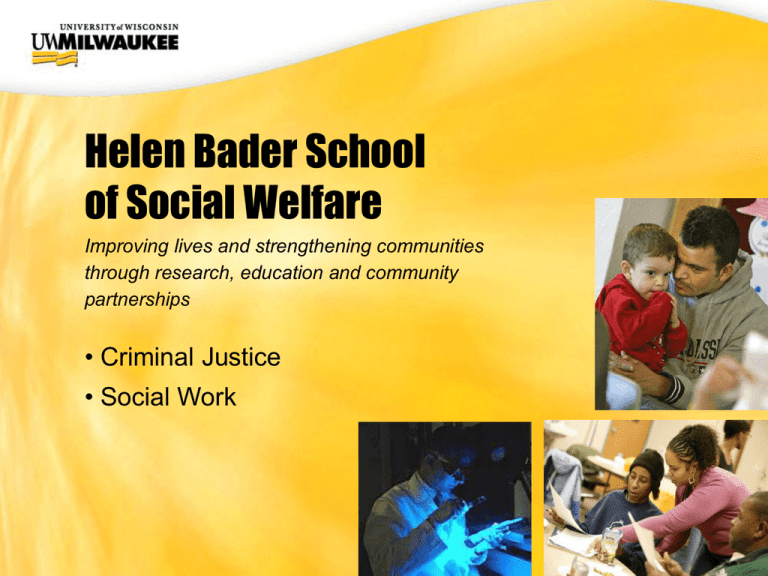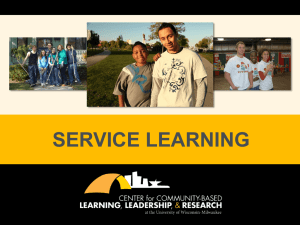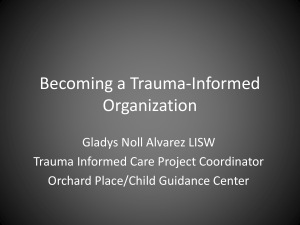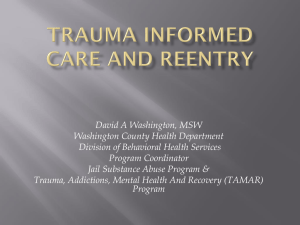
UWM CIO Office
Helen Bader School
of Social Welfare
Improving lives and strengthening communities
through research, education and community
partnerships
• Criminal Justice
• Social Work
UWM CIO Office
Effects of Child Maltreatment
& Effective Approaches to Treatment
Dimitri Topitzes, PhD, LCSW
UWM CIO Office
Agenda
• Define maltreatment trauma
• Discuss primary and second symptoms of trauma
• Explore variations of trauma informed care (traumasensitive, trauma-informed, trauma-focused)
• Examine phases of trauma-focused interventions
• Review promising approaches
UWM CIO Office
Potential Traumatic Event
• Trauma is a two-fold phenomenon: exposure and symptoms
• Potential traumatic event (as defined by DSM V):
• Death/threatened death, actual/threatened serious physical injury,
actual/threatened sexual violence
• Direct experience, witnessing, or learning about love one (if death, then
sudden), secondary exposure (VT)
• Examples…childhood physical abuse, witnessing IPV, invasive medical
procedures, war, violent crime, car accident, etc.
• Is this an exhaustive definition?
• Chronic childhood neglect?
• Chronic emotional abuse in childhood or adulthood?
UWM CIO Office
Child Maltreatment
•
•
•
•
Official measures
Acts of commission or commission
Actor/s
Immediate consequences
– Physical/emotional harm, sexual abuse or exploitation
– Danger of or imminent risk of harm
• Generally a strict definitional standard
UWM CIO Office
Yearly Incidence
• 2006: 905,000 children substantiated for CAN (1 in 80) National
Child Abuse and Neglect Data System
• 2006: National Incidence Study-4: 2.9 million children victims
CAN (1 in 25).
• 2012: 686,000 maltreated children in the United States, a rate
of 9.2 per thousand
• Since 2012, abuse and neglect on decline. Abuse on declining
faster, neglect declining more slowly
• Why the decline?
• Yet, when broaden definition many more children affected
UWM CIO Office
Complex Trauma
• Multiple Incident: Type II
–
–
–
–
–
–
Often prolonged or enduring
Relational field
Context of social exploitation
Leads to complex symptom presentation
Often in childhood (due to vulnerable nature of children): CDT
Can be adulthood: DV, POWs, Victims of Sex Trade, etc.
UWM CIO Office
Primary Symptoms of Trauma
• Intrusion (re-experiencing, intrusive memories, nightmares,
dissociative flashbacks)
• Avoidance (effortful, thoughts and feelings, external reminders)
• Cognition &/or mood alterations (memory disturbance, self and
world schemas, negative mood)
• Hyperarousal (hypervigilance, sleep disturbance, aggression
and irritability, concentration problems)
• With children, more behaviorally based, regressive play, etc…
UWM CIO Office
Secondary Symptoms of Trauma (II)
• Secondary Symptoms or Trauma Consequences
– Extensive
– Short and long-term
• Cascade Effects: within
• Multifinality: across
UWM CIO Office
Short Term Secondary Symptoms
•
•
•
•
•
•
•
•
•
Internal representations of self and others
Attention regulation
Affect regulation
Behavior regulation
Cognitive development
Social adjustment
Academic performance
Motivational development
Self-concept
UWM CIO Office
Long-Term Effects of Complex Trauma
• Mental health impairments
• Behavioral health impairments
• Physical health impairments
• Educational attainment
• Human capital
• Criminality
Exercise
UWM CIO Office
Levels of Trauma-Informed Services
• Trauma-Sensitive
• Trauma-Informed
• Trauma-Focused
UWM CIO Office
Principles of Trauma-Informed and
Trauma-Focused Interventions
• Assess both acute and chronic forms of trauma
– Trauma history affect course of treatment
– Complex childhood trauma increases risk for acute
adult trauma
– Trauma can underlie multiple presentations
UWM CIO Office
Principles (cont’d)
• Address primary sx’s, secondary sx’s & causes:
– Primary symptoms:
• Address safety & safety appraisal
– Secondary Symptoms, short and long-term:
• Emotion regulation
• AODA treatment
– Causes or Trauma Memories
• Trauma memory resolution
UWM CIO Office
Principles of T.I.C.
• Relationship –
– Therapeutic alliance
• The Lower Brain Interventions–
– Calm, non-reactive interventionist always
– Somatosensory strategies
• Motivation–
– Individualized interventions that intrinsically motivates (e.g., client choices)
– Therapeutic window
• Coordinated systems of care
• Interventionist self care to prevent vicarious trauma
–
–
–
–
Personal support network
Personal hobbies
Spirituality
Supervision and consultation
UWM CIO Office
Phase-Based or Multi-Stage
Treatment Models (Indv.)
1. Safety (ID areas of danger or perceived danger)
2. Enhance networks of care
3. Attention/Emotion/Behavior Regulation
4. Building Other Self-Capacities, e.g., problem solving
5. Cognitive Restructuring or Reprocessing
6. Trauma Resolution through Play/Memory/Narrative Work
7. Meaning Making or Future Self
UWM CIO Office
Models
• TF-CBT (cognitive processing demonstration #3)
• Trauma Systems Therapy
• Integrative Treatment of Complex Trauma
• Expressive Therapies
• Trauma Narrative Therapy
• Parent Child Interaction Therapy
UWM CIO Office
Thank you
Dimitri Topitzes, PhD, LCSW
Associate Professor
Helen Bader School of Social Welfare
University of Wisconsin-Milwaukee
topitzes@uwm.edu
414-229-3004








